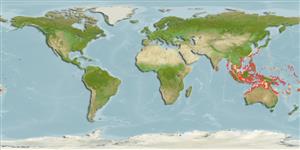Common names from other countries
Environment: milieu / climate zone / depth range / distribution range
Ekologi
Berasosiasi dengan karang; kisaran kedalaman 0 - 40 m (Ref. 847). Tropical; 36°N - 26°S, 32°E - 172°W (Ref. 847)
Indo-West Pacific.
Length at first maturity / Size / Weight / umur
Maturity: Lm ? range ? - ? cm Max length : 100.0 cm TL jantan/; (Ref. 269)
A solitary, free-living species often found in large aggregations at intermediate depths on reef slope benches. The coral is moderately elongate (length to width ratio between 1.5 and 3 to 1) and may reach 1 m in length. Both upper and lower surfaces are very rough due to septal and costal dentations (Ref. 269).
The coral is moderately elongate (length to width ratio between 1.5 and 3 to 1) and may reach 1 m in length (Ref. 269). A solitary, free-living species often found in large aggregations at intermediate depths on reef slope benches (Ref. 269). Also on reef flats (Ref. 98471).
Life cycle and mating behavior
Kematangan | Reproduksi, perkembang biakan | Pemijahan | telur-telur | Fecundity | Larva
Members of the class Anthozoa are either gonochoric or hermaphroditic. Mature gametes are shed into the coelenteron and spawned through the mouth. Life cycle: The zygote develops into a planktonic planula larva. Metamorphosis begins with early morphogenesis of tentacles, septa and pharynx before larval settlement on the aboral end.
rujukan utama
Acuan | Koordinator | mitra
Veron, J.E.N. 2000. (Ref. 847)
Status IUCN Red List (Ref. 130435)
status CITES (Ref. 108899)
Not Evaluated
penggunaan manusia
| FishSource |
Alat, peralatan
informasi lanjut
Umur / SaizPertumbuhanpanjang-beratpanjang-panjangMorfologiLarvaKelimpahan
Sumber internet
Estimates based on models
Preferred temperature
(Ref.
115969): 25.2 - 29, mean 28.2 (based on 806 cells).
keancaman
High vulnerability (60 of 100).
kategori harga
Unknown.
